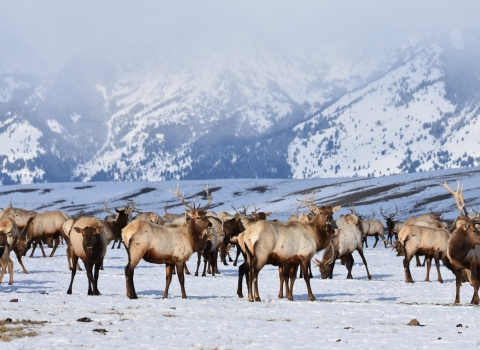What We Do
Wildlife conservation is at the heart of the National Wildlife Refuge System. It drives everything on U.S. Fish and Wildlife Service lands and waters managed within the Refuge System, from the purposes for which a national wildlife refuge national wildlife refuge
A national wildlife refuge is typically a contiguous area of land and water managed by the U.S. Fish and Wildlife Service for the conservation and, where appropriate, restoration of fish, wildlife and plant resources and their habitats for the benefit of present and future generations of Americans.
Learn more about national wildlife refuge is established to the recreational activities offered to the resource management tools used. Using conservation best practices, the Refuge System manages Service lands and waters to help ensure the survival of native wildlife species.
Management and Conservation
Bison & Elk Management Plan
The Bison and Elk Management Plan was finalized in Spring 2007. This 15-year plan guides management of bison and elk for both the National Elk Refuge and Grand Teton National Park.
Step-Down Plan
The Step-Down Plan - Bison and Elk Management was finalized in 2019. Current Refuge goals are to reduce reliance on supplemental feeding to mitigate disease risk and prevent habitat degradation on the landscape.
Chronic Wasting Disease Response Strategy
Chronic Wasting Disease, or CWD, is a transmissible spongiform encephalopathy and is fatal. In 2020, an elk in Grand Teton National Park tested positive for CWD. In response, the National Elk Refuge is increasing surveillance during all field operations to watch for animals displaying symptoms of CWD; euthanizing and testing suspect animals; coordinating public outreach with state, federal, and local partners. More information is available in the National Elk Refuge Chronic Wasting Disease Response Strategy.
Comprehensive Conservation Plan
The Comprehensive Conservation Plan (CCP) was finalized in Fall 2016. This 15-year plan guides the management and use of the National Elk Refuge.
Habitat Management
The National Elk Refuge adaptively manages bison, elk, and other wildlife populations and their habitat. Staff at the Refuge operate an extensive irrigation program that runs from spring through summer annually. The irrigation program focuses on producing high-quality, standing forage for wintering elk and bison.
Our Services
Find information about our permits and application forms for commercial activities, research and monitoring and general activities.
Special Use Permits
Some commercial, recreational, and research activities are allowed on national wildlife refuges only with a special use permit issued by the local office, and are subject to specific conditions and fees. This permit requirement is meant to ensure that all activities at the federal site are compatible with the refuge’s Congressionally mandated wildlife conservation goals. Special use permits may limit the scope, timing and location of the activity, as determined by the refuge where the activity would take place.
Commercial Activities
Includes: workshops, professional photography, & wildlife viewing tours. Application Form
Research & Monitoring
Includes: biological work & geological monitoring. Application Form
General Activities
All other permits. Application Form
For questions or to submit completed application form, please email Raena Parsons, Visitor Services Manager: raena_parsons@fws.gov
A minimum of ten business days is required to request a permit.
Our Projects and Research
Using conservation best practices, the Refuge System manages Service lands and waters to help ensure the survival of native wildlife species.
Wildlife conservation is at the heart of the National Wildlife Refuge System. It drives everything on U.S. Fish and Wildlife Service lands and waters managed within the Refuge System, from the purposes for which a national wildlife refuge national wildlife refuge
A national wildlife refuge is typically a contiguous area of land and water managed by the U.S. Fish and Wildlife Service for the conservation and, where appropriate, restoration of fish, wildlife and plant resources and their habitats for the benefit of present and future generations of Americans.
Learn more about national wildlife refuge is established to the recreational activities offered to the resource management tools used. Using conservation best practices, the Refuge System manages Service lands and waters to help ensure the survival of native wildlife species.
Current and recent projects include:
- Monitoring and researching the population and distribution of the Jackson Elk Herd
- Monitoring for wildlife diseases in ungulates
- Weed mapping
- Trumpeter swan nesting season observations
- Curlew observations
- Pollinator surveys
SHORT-TERM EXTENSION OF STEP-DOWN PLAN
In 2019, the National Elk Refuge (Refuge) finalized a Bison and Elk Step-Down Plan (Step-Down Plan) that authorizes and provides management direction for bison and elk on the Refuge. The Step-Down Plan is set to expire at the end of the 2024. Currently, the U.S. Fish and Wildlife Service (Service) is continuing development of the draft Bison and Elk...
Law Enforcement
The mission of the U.S. Fish & Wildlife Service is to protect wildlife and plant resources through the effective enforcement of federal laws.
Laws and Regulations
Law enforcement is essential to virtually every aspect of wildlife conservation. Refuge officers work with other Federal and State law enforcement personnel and the Teton County Sheriff's Department to make the National Elk Refuge a better place for wildlife and people.






